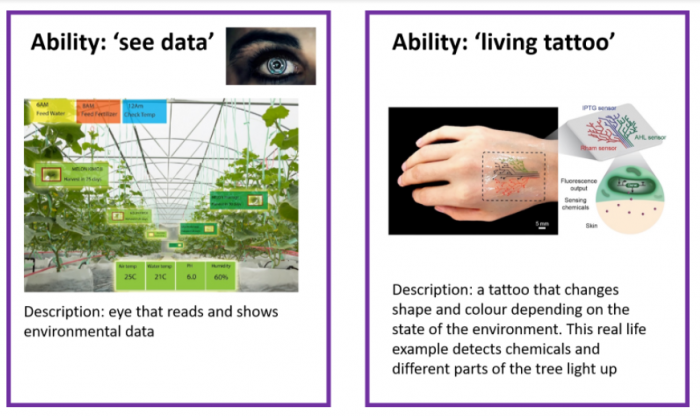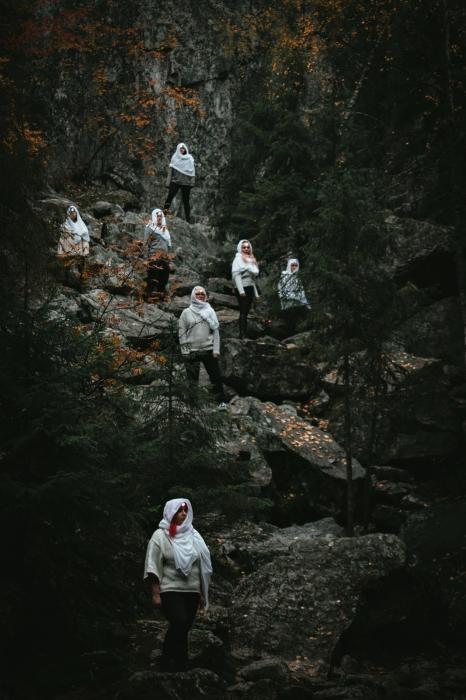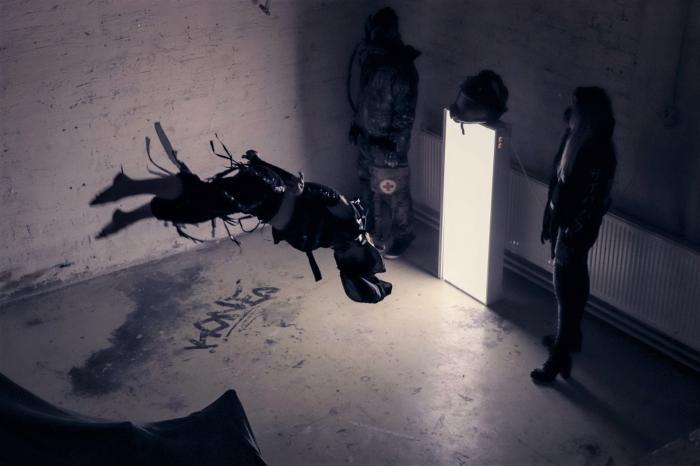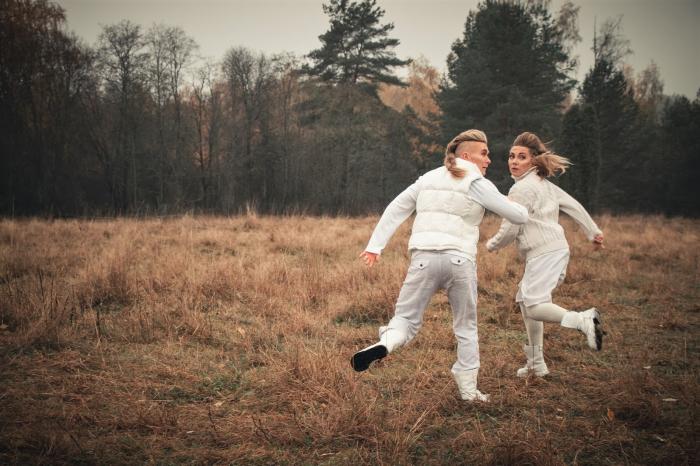I. SUMMARY INFORMATION
Project
268019
Status
Submitted
Award category
Techniques, materials and processes for construction and design
You want to submit
NEW EUROPEAN BAUHAUS AWARDS : existing completed examples
Project title
SciberCity
Full project title
SciberPunks as future personas for more-than human design scenarios
Description
SciberCity has developed a method that blends design and sustainability to create future personas in the form of 'SciberPunks'. These are augmented humans with capabilities to listen to and speak on behalf of the concerns of the environment and creatures that inhabit it. They are based on real environmental data and are meant to help urban design teams consider beyond human concerns when designing cities or other spaces, and to better understand the impacts of certain design choices on nature.
Where was your project implemented in the EU?
Finland
Etelä-karjala
Yliopistonkatu 34
Lappeenranta
53850
When was your project implemented?
Has your project benefited from EU programmes or funds?
Yes
Which programme(s) or fund(s)? Provide the name of the programme(s)/fund(s), the strand/action line as relevant and the year.
The project was selected for 25K euro worth of funding via the Designscapes (H2020) project (763784) CO-CREATION-02-2016 - User-driven innovation: value creation through design-enabled innovation (2017-2021)
II. DESCRIPTION OF THE PROJECT
Please provide a summary of your project
The SciberCity project developed and tested a methodology for creating SciberPunks, a type of 'future persona' that can be used to guide more sustainable design decisions. A key focus of the project was to examine how environmental data and other forms of environmental information might act as a bridge between people and nature, one that can be used to build empathy towards problems that might otherwise remain unnoticed. SciberPunks were born from an idea ‘what if we could augment humans to feel data- what would this experience be like? How might this change our relationship to the environment and to each other?' As such, a SciberPunk is an imagined augmented human, with the ability to act as a voice for the environment and its non-human inhabitants by feeling and expressing data related to them, such as having the ability to taste pollution data, smell the destruction of habitats and communicate it through living tattoos on the skin. It built on a previous project CyberPunk 2085 which produced lots of futuristic characters, including props and videos, but without augmentation for channeling data. SciberPunks are imagined through a co-creation process, which draws on knowledge gained by finding patterns and trends in real data and which is supported by data literacy techniques combined with arts-based approaches for embodying environmental data and building empathy through it. SciberPunks contribute to sustainable and aesthetic design in two ways. First, the process of building the characters supports the participants to examine more closely the environmental concerns and to find 'hidden' problems that data may reveal about positive or worrying environmental trends. Second, the characters themselves are designed to be able to communicate these ideas quickly and effectively to a wider audience, in a novel way designed to engage the audience. The project produced and tested a set of activities for co-creating SciberPunks, which yielded 5 unique future personas.
Please give information about the key objectives of your project in terms of sustainability and how these have been met
A key objective was to provide practical answers to the social question of how to design modern life in harmony with nature? According to the United Nations, by 2050 more than two thirds of the world's population will live in urban areas and are at risk of losing their connection to nature. This could breed environmental apathy or biophobia where nature is seen as a disposable resource, leading to repercussions on the planet's health if such thoughts are reflected in urban design. This works against emerging design philosophies such as more-than-human approaches that aim to foreground the environment and it's non-human inhabitants in design processes.
Simply providing access to information is not enough to change people's minds on environmental issues, it is more critical to build empathy towards the natural world. Empathy can be built by direct nature encounters. But not everyone has the privilege of time or money to regularly travel to and make use of green spaces. The question is how to make nature experiences more accessible to people in such circumstances and in a way that helps to build empathy? Thus, a key objective of SciberCity in terms of sustainability was to explore how arts-based methods might be utilised along with data literacy techniques to build empathy towards environmental concerns via real environmental data sets in co-creative activities.
We assessed our outcomes from co-creation by doing analysis of conversations throughout the whole process and by evaluating the produced artefacts (the SciberPunks). We found evidence of empathy towards nature, expressed as sadness at the impact of human activity and fear of what will happen next. To mitigate against such fears, participants bestowed upon their future personas the abilities to sense each others needs, having precognition of danger and being able to sense when nature is in pain. Thus, the five personas produced differed from more traditional personas by strong connections to nature.
Please give information about the key objectives of your project in terms of aesthetics and quality of experience beyond functionality and how these have been met
A key aim of the SciberCity project was to make data more easy and fun to engage with as part of sustainable decision-making. We therefore focused on a) the quality of the experience of participating with the co-design activities b) the quality of the outcome and how they would be presented to others. We were particularly interested in the experiential aspects of engaging with data and how we might foster creative and sensory experiences with it. To support this, the project used creative and arts-based methods with a focus on pre-text process drama which is influenced by oral storytelling and literary and performing art techniques. Participants in the project created their own SciberPunk characters, starting from an original idea of a character and elaborating it each time they had engaged with new evidence. But rather than just presenting evidence in an ordinary ways (e.g. graphs and charts and web pages), we first created a number of activities designed to encourage participants to engage with data and other information and then to express this by role-playing, acting, sketching, writing stories, creating montages and similar activities that provoked different viewpoints on it. Some activities were individual and some were done in groups of two or more. Next we created a narrative arc, that took participants on a journey through time from the past, into the present and then to the future, following 3 characters: Raven Etiäinen, Shadow and Light. The premise was that in order to understand how things are right now, and what could happen in the future, it is necessary to first look back and understand what different environmental trends may occur and what could factor into those, for example loss of species, rise or fall of air or water pollution and similar. The original aim was to present SciberPunks as fully formed characters using props and videos as in the original CyberPunk activity. COVID meant that outputs are for now realised mostly as sketches.
Please give information about the key objectives of your project in terms of inclusion and how these have been met
Participation - especially public participation - in municipal decision making especially around urban issues often requires the ability to find, make sense of and communicate about environmental data that highlight potential concerns. This includes - just to give examples - submitting objections against planning proposals for factories that may produce water pollution or housing developments that would cause decline in insect or other species. Often in such situations it is necessary to both find evidence based on similar cases and then to find and assess local data to build the grounds for objection. Similarly, in participatory planning cases, to be really inclusive everyone needs to be able to access and understand the same information.
The SciberCity project has focused on inclusion in terms of developing methods that make it easier to find and make sense of environmental data and also to communicate it. These approaches drew on data literacy techniques, combined with arts-based approaches designed to lower barriers to participation and were used in the co-creation activities to engage participants with key environmental evidence from a local swamp area called Linnaistensuo. The co-creation activities were undertaken by 5 youth who did not have prior expertise in understanding environmental data sets. Still, these participants showed evidence of using the data in describing the development of their characters through sketches, stories, poems and similar artefacts.
At the same time, we consider inclusion in urban design to be also about inclusion of more than human actors into the urban planning process. How can trees, plants, insects and other animals be included in a design process, how can their voice be heard? Our approach is designed to make their needs more visible, based on real scientific evidence and data.
Please give information on the results/impacts achieved by your project in relation to the category you apply for
We are applying for the category 'techniques, materials and processes for construction and design'. Our project has created a new methodology that can be replicated in different contexts for understanding environmental impacts in urban planning processes and that encourages participation from those who might otherwise be excluded due to data literacy and similar barriers preventing them from engaging with and making sense of important evidence. Our approach is also designed to communicate about the needs of those who don't normally have a voice in design, including the environment and the creatures who inhabit it. We consider both the co-creation activities themselves and the artefacts they produce to be important in creating impact. First, impact is achieved by the new knowledge and empathy towards environmental concerns of those who participate in creating SciberPunk characters and how this is reflected in any urban planning decisions they participate in. Second, impact is achieved by the secondary use of such characters, which could also be as part of co-creation for more sustainable building and planning processes but at a less involved/participatory level (for example, to scale up the impact of the knowledge gained through the initial co-creation process) or for communicating effectively to others about the planning process and inspiring more sustainable planning and decision-making in the future. In terms of result, the project has already produced 5 unique SciberPunk future personas that could be used in urban planning scenarios. Having SciberPunk characters speak instead of people allows for a certain amount of aesthetic distancing which can allow for objectivity and letting evidence speak for itself, not just people’s personal opinions that can be more easily disputed. We have also communicated workshop outcomes to professionals in the field of urban planning, landscape design and participation & engagement.
Please explain the way citizens benefiting from or affected by the project and civil society have been involved in the project and what has been the impact of this involvement on the project
The main impacts of the project so far have been on the participants themselves, who were all citizens of Lahti (in Finland) but also young adult students who were engaging with a drama pedagogy programme. By participating in SciberCity they have learned and more importantly experienced for themselves new ways of mediating activities using arts-based methods which they may take forward into their own practice. The outputs of the project also have the capability to be utilised in other activities. In particular the future persona ‘SciberPunks’ have the possibility to be evaluated with regard to how they communicate and give voice to environmental concerns during urban planning scenarios. In addition an evocative report plus the original activity sheets themselves are available to give a reference point for anyone who would like to replicate this approach in their own setting. In the future when the approach is refined an instructional booklet will be created on how to develop and use future personas in urban planning and other design tasks. The impacts are less than they should have been in the original framing of the project. Originally, the workshops would have taken place in a face to face setting, and there would have already been follow up activities using the personas in real urban planning situations. COVID has impacted these activities, firstly the co-creation took place only online and this meant reducing drastically the amount of participants from around 30 to just 5 who took part on a continued basis.Secondly, the urban regeneration project that is ongoing and that would allow us to evaluate the methods in real life design scenarios has also been delayed in parts due to the covid situation. However, they should still take place later in 2021.
Please highlight the innovative character of the project
In SciberPunk, we used both arts-based methods and storytelling and narrative techniques to structure empathic experiences around data in the process of defining characteristics of new future personas. The concept of a persona originated as a way of giving designers a more concrete reference point from which to make design decisions. Personas are a fictional user archetype that give a ‘name and face’ to a type of user or a product or service, describe their important characteristics, expectations, motivations and typical frustrations. Methods for creating personas include direct access (e.g. observation, focus groups with consumers) and indirect access methods, such as using expert knowledge of a system and its users, often combined with insights gained from analyzing different sources of data, including ethnographic data, market research, click-stream analytics and social media data. The majority of personas are intended to represent typical users of a product. The novelty of a SciberPunk persona is that they give a name and a face to the 'non human' and provide a viewpoint that may be otherwise hard to imagine. They retain some human characteristics (they are not 'tree' or 'bat' personas) in order to make them more relatable to those using them in design. Our approach is also innovative in the way it focuses on empathy building through real data. Other approaches being framed for supporting more-than human design rely on imagining the world from an alternative, e.g. animal point of view. Like traditional personas, they are still formulated through concrete evidence as well as personal experience, not just imagination. A further novelty of the approach is in combining arts-based approaches with data literacy in order to make the data both easier and more enjoyable to engage with. While there are some creative approaches for supporting data literacy, there are less that encourage embodying data in the way that arts-based and especially drama based approaches allow.
Please explain how the project led to results or learnings which could be transferred to other interested parties
Whilst the SciberCity project produced and tested materials related to a specific set of data and information about a nature area in Lahti, Finland, the approach itself is easily extensible and can be framed around different scenarios, using the same approaches but with different data. To completely recreate the experience end to end, including all activities and tailoring the narrative to suit would be quite resource intensive but potentially worth it especially for high stakes projects. However, it is also possible to adopt a more lightweight approach and just reuse some of the activities as suitable. For example, it would be possible to reuse any or all of the arts-based approaches for embodying and role-playing datasets, the curation techniques for making the datasets more digestible, the overall concept of creating SciberPunks from real data but without the co-creation aspects of their production and finally any of the SciberPunk characters themselves and their capabilities for feeling data that could be used for reflection within design scenarios. For example, Warmonk is a shaman character who communicates with plants and trees using his staff that he built using old world technology. The staff keeps his mind and body connected to nature. What would Warmonk think about this urban design scenario given that he would be able to feel the fear of the bats who would be displaced when the trees which are their natural habitat are cut down?
Is an evaluation report or any relevant independent evaluation source available?
III. UPLOAD PICTURES
IV. VALIDATION
By ticking this box, you declare that all the information provided in this form is factually correct, that the proposed project has not been proposed for the Awards more than once under the same category and that it has not been subject to any type of investigation, which could lead to a financial correction because of irregularities or fraud.
Yes





